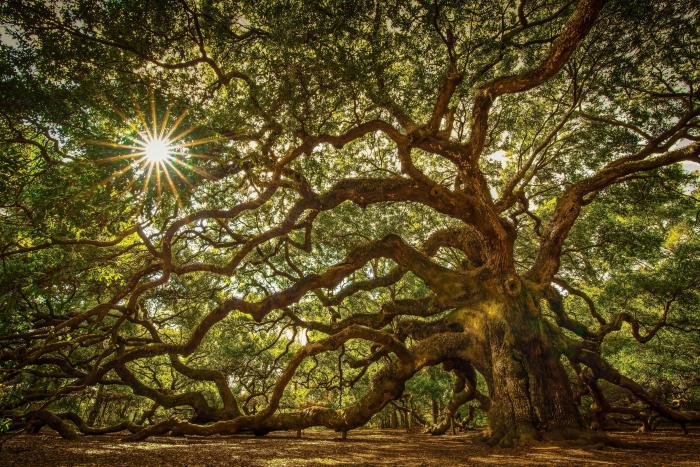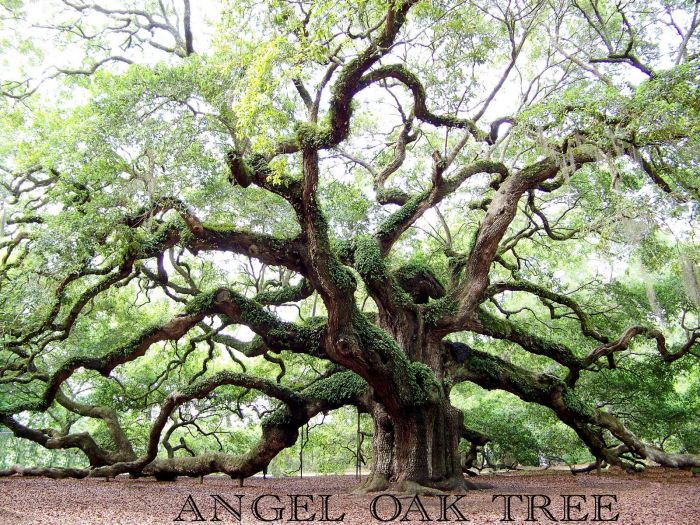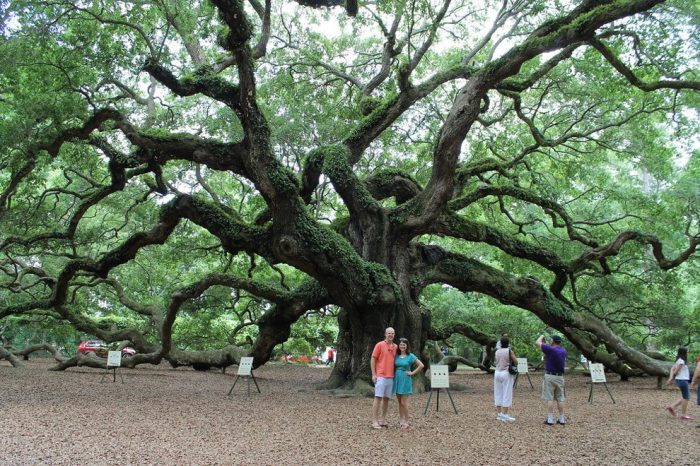Angel oak tree – In the heart of the picturesque town of Charleston, South Carolina, stands a majestic and ancient live oak tree known as the Angel Oak. With its gnarled branches stretching out like the wings of an angel and a trunk that has witnessed centuries of history, this tree has become an iconic symbol of the region.
This venerable tree is estimated to be between 400 and 500 years old, towering over the surrounding landscape at a height of over 66 feet. Its massive trunk has a circumference of nearly 28 feet, making it one of the largest live oaks in the United States.
Tree Profile
The Angel Oak tree is a live oak tree (Quercus virginiana) located on Johns Island, Charleston, South Carolina, United States.
The majestic Angel Oak Tree stands tall and proud, its sprawling branches reaching towards the sky. Its gnarled trunk has witnessed centuries of history. If you’re planning a visit to see this natural wonder, be sure to check the Amsterdam weather forecast to ensure a pleasant and memorable experience.
While you’re in the area, don’t miss the opportunity to explore the enchanting surroundings and immerse yourself in the beauty of this ancient tree.
It is estimated to be between 400 and 500 years old, making it one of the oldest living oak trees in the world. The tree is 66.5 feet (20.3 m) tall and has a circumference of 28 feet (8.5 m) at its base. The Angel Oak tree is located in a public park and is a popular tourist destination.
Habitat
The Angel Oak tree is located in a maritime forest, which is a type of forest that is found along the coast. Maritime forests are characterized by their salt-tolerant trees and shrubs, which are adapted to the harsh conditions of the coastal environment. The Angel Oak tree is one of the largest trees in the maritime forest on Johns Island.
Historical Significance

The Angel Oak tree is not only a magnificent natural wonder but also holds significant cultural and historical value. It has witnessed the passage of time, serving as a silent observer of the rich tapestry of events that have unfolded beneath its ancient canopy.
The tree’s historical significance is deeply intertwined with the history of the Charleston area. It is believed to have been a sacred gathering place for Native Americans long before the arrival of European settlers. Its sprawling branches provided shelter and a sense of community for the indigenous peoples who inhabited the land.
Legends and Stories
Over the centuries, the Angel Oak tree has become a source of local folklore and legends. One popular tale tells of a young woman who sought refuge under its branches during a fierce storm. As the winds howled and the rain poured, she prayed for protection, and her prayers were answered when the storm miraculously passed over the tree, leaving it and the woman unharmed.
Another legend suggests that the tree is home to the spirits of those who have passed away. Locals whisper that on moonlit nights, the faint sound of voices can be heard emanating from its ancient trunk.
The Angel Oak Tree, with its sprawling branches and centuries-old history, is a testament to the enduring beauty of nature. Its majestic presence reminds us of the timeless wonders that surround us. Like the cobbled streets and ancient ruins of Alcudia , the Angel Oak Tree invites us to explore the rich tapestry of our world and appreciate the heritage that connects us.
Historical Events and Figures
The Angel Oak tree has also been a witness to some of the most pivotal moments in American history. During the Civil War, it is said that Confederate soldiers camped beneath its branches, using its massive trunk as a lookout point. The tree survived the war and continued to stand tall as the nation rebuilt.
In more recent times, the Angel Oak tree has become a popular tourist destination, drawing visitors from around the world who marvel at its grandeur and historical significance. It has been featured in countless photographs, paintings, and other works of art, further cementing its place in the cultural fabric of the Charleston area.
Ecological Importance
Angel Oak Tree is a cornerstone of the local ecosystem, providing vital resources and shelter to a diverse array of organisms. Its sprawling canopy creates a microclimate that supports a rich understory of vegetation and provides refuge for numerous animal species.
The tree’s deep roots help stabilize the soil, preventing erosion and improving water retention. Its leaves decompose and release nutrients into the soil, enriching the surrounding ecosystem and fostering plant growth.
Habitat for Wildlife
The Angel Oak Tree serves as a sanctuary for a variety of wildlife, including birds, mammals, reptiles, and amphibians. Its dense foliage provides nesting and roosting sites for birds such as owls, hawks, and songbirds. The tree’s trunk and branches offer shelter and protection for squirrels, raccoons, and other small mammals.
The tree’s root system creates a moist and sheltered environment that is ideal for amphibians such as frogs and salamanders. Its canopy provides shade and protection from predators, making it a valuable habitat for these creatures.
Tourism and Recreation

The Angel Oak Tree has become a renowned tourist attraction, drawing visitors from around the globe. Its captivating presence and historical significance make it a must-see destination.
Surrounding the tree, a range of recreational activities cater to diverse interests. Visitors can embark on scenic walks along the designated trails, enjoying the serene beauty of the surrounding nature. Picnics beneath the tree’s majestic canopy offer a delightful respite, allowing for relaxation and rejuvenation.
Economic Impact, Angel oak tree
The Angel Oak Tree has had a profound economic impact on the surrounding area. Its popularity as a tourist destination has spurred the growth of local businesses, such as gift shops, restaurants, and tour operators. These establishments cater to the influx of visitors, contributing to the local economy.
Conservation and Preservation

The Angel Oak Tree is a cherished natural landmark that has received significant attention and efforts for its conservation and preservation. Various organizations and individuals have played a vital role in protecting this iconic tree from environmental threats and ensuring its longevity.
Preservation Efforts
The City of Charleston has designated the Angel Oak Tree as a protected tree, prohibiting any alterations or damage to its structure or surrounding environment. The tree is also included in the National Register of Historic Places, further safeguarding its preservation.
- Tree Protection Zone: A 100-foot radius around the tree has been established as a protected zone, limiting any development or construction activities that could potentially harm its root system or canopy.
- Pruning and Maintenance: Regular pruning and maintenance are conducted by certified arborists to remove dead or diseased branches, promote healthy growth, and prevent the spread of pests and diseases.
Environmental Threats
Despite the conservation efforts, the Angel Oak Tree faces several environmental threats that require ongoing monitoring and mitigation:
- Climate Change: Changing climate patterns, such as rising temperatures and altered precipitation, can impact the tree’s health and resilience.
- Diseases and Pests: The tree is susceptible to various diseases and pests, including oak wilt and oak leaf blight, which can cause significant damage to its foliage and overall health.
- Soil Compaction: Foot traffic and nearby construction activities can lead to soil compaction, hindering the tree’s ability to absorb nutrients and water.
Future Plans
The conservation and preservation of the Angel Oak Tree remain a priority for the community and various organizations. Future plans include:
- Education and Outreach: Raising awareness about the tree’s historical and ecological significance, as well as the importance of its preservation.
- Research and Monitoring: Conducting ongoing research and monitoring to better understand the tree’s health, environmental threats, and potential conservation measures.
- Sustainable Tourism: Implementing sustainable tourism practices to minimize the impact of visitors on the tree and its surroundings.
By addressing these conservation and preservation challenges, the Angel Oak Tree can continue to thrive as a living symbol of Charleston’s rich history and a testament to the importance of protecting our natural heritage.
Artistic Representations: Angel Oak Tree

The Angel Oak Tree has captured the imagination of artists for centuries, inspiring a wide range of artistic representations.
Paintings and sculptures depict the tree’s majestic form and intricate root system, while photographs capture its beauty and grandeur. The tree has also been featured in films, television shows, and music videos.
Paintings
Paintings of the Angel Oak Tree often portray its massive trunk and sprawling branches. Artists have used a variety of styles to capture the tree’s unique character, from realism to impressionism.
One famous painting of the tree is by American artist Jasper Francis Cropsey, who depicted the tree in his 1854 work “Live Oaks, Charleston, South Carolina.” The painting shows the tree surrounded by a group of people, highlighting its importance as a gathering place.
Prepare to be awe-inspired by the grandeur of the legendary Angel Oak Tree, a breathtaking natural wonder that has stood the test of time. While immersing yourself in the serene ambiance beneath its sprawling branches, don’t miss out on exclusive luxury travel deals that will elevate your journey to unparalleled heights.
Return to the enchanting embrace of the Angel Oak Tree, where its timeless beauty will linger in your memory long after your visit.
Sculptures
Sculptures of the Angel Oak Tree often focus on its intricate root system. Artists have used a variety of materials to create these sculptures, including bronze, stone, and wood.
One notable sculpture of the tree is by American artist John Seward Johnson II. His 1990 work “Angel Oak” is a bronze sculpture that depicts the tree’s roots as a group of human figures. The sculpture is located in the Charleston Museum.
Photography
Photographs of the Angel Oak Tree often capture its beauty and grandeur. Photographers have used a variety of techniques to capture the tree’s unique character, from long exposure shots to aerial photography.
One famous photograph of the tree was taken by American photographer Ansel Adams in 1958. The photograph shows the tree from below, highlighting its massive trunk and sprawling branches.
Symbolism and Significance
The Angel Oak Tree has been used as a symbol of strength, resilience, and longevity. Its image has been used on stamps, coins, and other commemorative items.
The tree has also been featured in literature and music. In his poem “The Angel Oak,” American poet Sidney Lanier described the tree as a “giant sentinel” and a “symbol of strength and beauty.”
Final Conclusion
The Angel Oak Tree is a testament to the enduring power of nature and the rich history of the American South. As a living symbol of resilience and beauty, it continues to inspire awe and wonder in all who behold it, ensuring its legacy as a cherished landmark for generations to come.
Frequently Asked Questions
Where is the Angel Oak Tree located?
The Angel Oak Tree is located in Charleston, South Carolina, on Johns Island.
How old is the Angel Oak Tree?
The Angel Oak Tree is estimated to be between 400 and 500 years old.
What is the circumference of the Angel Oak Tree’s trunk?
The circumference of the Angel Oak Tree’s trunk is nearly 28 feet.